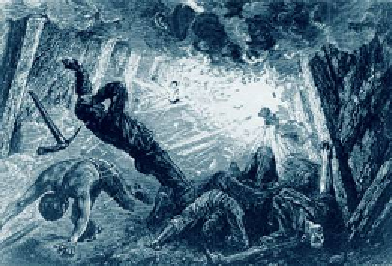Environmental Engineering Reference
In-Depth Information
FIGURE 13.11
The Fire Triangle
Methane is highly explosive in air con-
centrations between 5 and 15 mol%
Source:
OSM 2001
Oxygen
12%
captured in many countries and used for heating and power generation. For example, cap-
tured coal bed methane (CBM) accounts for about 7.5% of the total natural gas produc-
tion in the USA. Techniques for removing methane from deep mine workings have been
developed primarily for safety reasons, because it is highly explosive in air in concentra-
tions between 5 and 15 mol% (
Figure 13.11
). However, the same techniques are increas-
ingly being used to capture methane gas for use as fuel, thereby reducing CMM emissions
by up to 90% (Bennet
et al.
1995).
Pre-mining degasii cation, often termed pre-draining, recovers methane from virgin
seams, before coal is mined. Increasingly, degasii cation is becoming economic without
subsequent coal mining. Coal bed methane is the same compound as occurs in natural gas,
but is derived from a different geological situation. The gas has a wide variety of energy-
related uses, and with the current energy crisis and relatively high fuel prices, increased
attention is being focused on development of this resource.
Degasii cation is a relatively low technology enterprise, requiring limited capi-
tal expenditure. However extraction of coal bed methane is not without controversy.
Increased production of coal bed methane carries with it some technological and environ-
mental difi culties and costs. In a conventional oil or gas reservoir, for example, gas l oats
on oil, which, in turn, l oats on water. An oil or gas well draws only from the petroleum
that is extracted without producing a large volume of water. But water also permeates coal
beds, and its pressure traps methane within the coal. To produce methane from coal beds,
water must be drawn off i rst, thereby lowering the pressure so that methane can l ow out
of the coal and to the well or bore (
Figure 13.12
)
. The quantity quality, and disposal of this
water are a source of much debate.
CBM-produced water is pumped in large volumes from the coal seams to the surface
to release the gas trapped in the coal seams. It can be discharged to the land surface, to
surface water, stored in evaporation ponds, used for stock or wildlife watering, re-ini l-
trated, injected back into the aquifer, or treated for various uses. Without treatment, its
discharge may have signii cant impacts on water quality. CBM-produced water can
contain concentrations of sodium total dissolved solids (TDS), total suspended solids
(TSS), l uoride, chloride, ammonia, and metals higher than those of the receiving waters.
The sodium adsorption ratio (SAR) is the ratio of the sodium ion concentration to the
combined concentrations of calcium and magnesium ions in water. Water with high SARs
can cause soils to become dispersed, less permeable (resulting in reduced plant growth)
and more prone to erosion; such waters may not be appropriate for irrigation. High
levels of soil salinity, resulting from irrigation with some CBM-produced water can
reduce crop yields. The cumulative effects of CBM-produced water on agricultural
To produce methane from coal
beds, water must be drawn
off fi rst, thereby lowering the
pressure so that methane can
fl ow out of the coal and to the
well or bore.













Search WWH ::

Custom Search